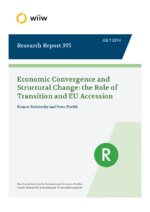Economic Convergence and Structural Change: the Role of Transition and EU Accession
Rumen Dobrinsky and Peter Havlik
wiiw Research Report No. 395, July 2014
31 pages including 6 Tables and 6 Figures
Summary
This paper analyses the speed and patterns of economic convergence in the new EU Member States of Central and Eastern Europe during transition and the first years of EU membership. After a brief discussion of measurement and data issues, the paper provides stylised facts on growth and convergence in Europe, and explores various convergence measures proposed in the growth literature. It employs several analytical approaches in order to reveal convergence speed and patterns: univariate growth regressions, multivariate econometric analysis, including the testing of convergence models and running different growth regressions. The aim is to look at various aspects of convergence processes by using alternate approaches and then, by putting those together, to seek common and distinct features. We confirm that the one-off direct negative effects of the crisis on GDP growth were considerably stronger in the case of NMS. The growth patterns were interrupted and the convergence process slowed down. The paper underlines the significant, sometimes even increasing, heterogeneity of growth, pointing more generally to uneven economic convergence within the EU. This concerns not only the lasting differences between the NMS and the rest of the EU, but also significant dissimilarities between the growth patterns among individual countries within each of these subgroups.
Reference to wiiw databases: wiiw Annual Database
Keywords: economic growth, growth determinants, real convergence, European Union, Central and Eastern Europe
JEL classification: C21, C23, O11, O40, O52, O57, F43, F63
Countries covered: New EU Member States
Research Areas: Macroeconomic Analysis and Policy
